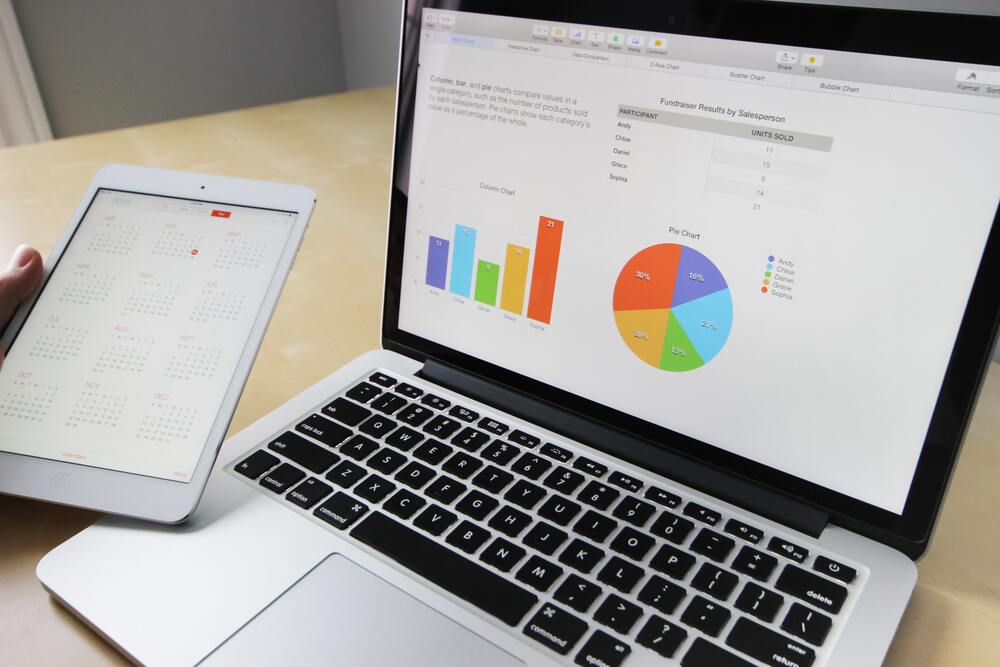When you start a business, there are various things to consider. One of them is making financial reports. This report contains financial activities that have existed for a certain period and can be used as a benchmark in making decisions.
There are 5 types of financial reports that you should understand to make it easier for you to prepare and read financial reports. Read more in the following information.
1. Definition of Financial Statements
Financial statements are documents that contain information about the financial condition of a business or company in a certain period. In this report, there is some important information consisting of a balance sheet, profit and loss, and a statement of changes in equity.
In other words, all forms of transactions that occur in a business or company, starting from buying, selling, and other financial transactions, will all be recorded in this type of financial report. Usually, this report is made within a certain time or period, for example, once a month or once a year.
Financial statements are generally prepared using fair value accounting principles and historical cost accounting principles.
The definition of financial statements according to experts has been summarized as follows.
1.1 Definition of Financial Statements According to Experts
1. Kasmir (2016:7)
According to Kasmir, financial reports are reports that show the company's financial condition at this time or a certain period.
2. Arief Sugiono dan Edi Untung (2016:1)
Both experts argue that financial statements are the end result of accounting activities (accounting cycle) that reflect the financial condition and results of operations of a company within a certain period of time.
3. Irham Fahmi (2017:22)
He explained that financial reports are information that describes the performance of a company.

Image Source: Pexels/Pixabay
2. Financial Report Function
The existence of financial reports is crucial for measuring the performance of a business or company and can be used as evaluation material for the next step.
If described in detail, the functions of the types of financial reports include the following:
1. Contains Information Regarding the Financial Condition of a Business or Company (Financial Transparency)
Financial reports are able to provide information about the company's financial condition in a transparent or open manner. Starting from information about profit and loss, assets, liabilities, and equity at a certain time. So, business owners or stakeholders of a company can find out the performance of the business that has been running.
2. Helps Manage Finances Better
For entrepreneurs, financial reports really help you manage business finances to be more organized. You can easily find out cash inflows and outflows, profit and loss, and have an idea of how your business can grow.
3. As Evaluation Material and Decision Making
Financial reports contain a series of important information that can be used as material for evaluation and decision-making. The information presented in it can be considered for making plans or actions in the future.
Helping you to identify opportunities that allow your business to grow and avoid business threats that may occur at any time.
4. Accountability Report
In large or public companies, financial reports are usually prepared as accountability report that contains the condition of a company. This report will be submitted to investors or stakeholders.
In addition, financial reports are also prepared to fulfill applicable legal obligations. For example, to facilitate the process of paying taxes and the like.
3. 5 Types of Financial Statements
There are at least 5 types of financial reports. The following is a brief explanation and example.
3.1. Balance Sheet
The first type of financial report is the balance sheet. The balance sheet is a company's financial report that records information related to assets, liabilities that must be paid to other parties, and capital owned by business owners in a certain period.
With this balance sheet, it will make it easier for business owners to identify the assets, liabilities, and capital needed in the coming period.
Not all types of companies record through this balance sheet report, especially in conventional businesses, and are classified as small-scale. It's another case, if a company has a large scale and has a legal umbrella, they generally already have a balance sheet report.
The form of a balance sheet is divided into two, namely control (horizontal or T-shaped) and Staffel (vertical).
In the type of balance sheet financial report, it must contain the following 3 elements:
- Assets
Assets are assets owned by business entities that are used to support business activities and can be converted into cash. These assets can be physical or non-physical assets originating from transactional activities or past activities.
Examples of assets in a business are cash/money, land, machine tools, inventory equipment, and property.
Meanwhile, non-physical assets can be in the form of royalties, patents, and intellectual property.
Generally, a company has 4 types of assets, namely:
- Current assets
- Fixed Assets
- Long-term investment (Long term investment)
- Intangible Fixed Assets
Usually, the Assets post is in the left position on the Balance Sheet.
- Obligation
Kewajiban adalah hutang yang dimiliki suatu entitas bisnis dan sifatnya wajib dibayarkan kepada pihak yang memberikan hutang. Contoh dari pos kewajiban ini adalah pinjaman jangka pendek dan jangka panjang, pajak, obligasi, dan lain-lain. Biasanya pos kewajiban berada di sisi kanan pada Laporan Neraca Keuangan.
- Equity
Equity is the capital included by the owner of a company. In other words, equity is the ownership rights to the company's assets after deducting the liabilities. This amount of equity will decrease if the owner of the company withdraws a certain number of assets. Usually, the location of this equity item is on the right side of the Balance Sheet together with the liabilities item.
3.2. Income Statement
The second type of financial report is the income statement. As the name implies, the income statement contains information about whether a company experienced a loss or profit in a certain period. Income statements are usually made at the end of the year or the end of the month. This type of financial report is very important for management because it is used as material for evaluating financial performance for 1 year. What are the points that can lead to gains or losses, whether there are costs that are too large to be charged or the income earned is in line with the target or not.
There are 4 elements contained in the income statement, namely:
- Revenue
- Expenses
- Profit
- Loss
To determine the profit earned, it is also divided into 5 types, namely:
1. Gross Profit
2. Operating Profit
3. Profit Before Tax
4. Net Income
5. Current Operating Profit
3.3. Cash Flow Statement
The third type of financial report is the statement of cash flows. A statement of cash flows or commonly called cash flow is a type of financial report that contains information about expenditures and cash inflows made by a business entity during a certain period. This information contains details regarding the amount of cash received, debt expenses and payments, and so on.
The function of the cash flow statement is as a means of evaluating the company's ability for future business activities. From the cash flow statement, it can be seen whether the company can pay its obligations/debt or not.
There are 3 important elements that must be included in the statement of cash flows, namely:
1. Operational Activities
Cash flows from operating activities can come from the sale of goods or services from customers, purchases of company equipment and tools that have an asset life of less than 1 year, and other operating expenses. In other words, cash flows from operating activities contain the company's main revenue-generating activities.
2. Investing Activities
Meanwhile, cash flows from investing activities are cash flows that include transactions for purchasing assets that have a lifespan of more than 1 year or long-term benefits. For example, buying stocks and bonds, purchasing property, and other equipment.
3. Financing Activities
The last component of the statement of cash flows is the component that comes from financing activities. This funding activity can come from activities that can increase or decrease the company's capital. Therefore, the financing activity post is closely related to dividend payments, repayment of long-term credit/debt, and the like.
3.4. Statement of Changes in Capital
A report on changes in capital or equity is a type of financial report that contains information about changes in equity at a certain time. Through this report, readers can see various changes related to incoming and used capital. This report is generally prepared after the income statement and balance sheet.
The capital change report consists of several important parts:
-
Initial capital
Contains information on the amount of existing capital at a certain time period.
-
Additional Capital
Contains information regarding the addition of business or company capital over a certain period of time. For example, additional capital in the form of dividend payments retained earnings and additional paid-in capital.
-
Decrease in Capital
Presents information regarding a decrease in existing capital at a certain time. For example, the decrease in the capital in the second quarter is due to last year's dividend payments that have not been paid.
-
Final Capital
Displays the amount of the final capital for a certain time.
The existence of a report on changes in the capital is very useful for business owners, stakeholders, investors, and parties who have authority over the company to find out changes in equity, evaluate, and plan the company's finances in the future.
3.5. Notes to Financial Statements
The fifth type of financial report is the Notes to Financial Statements. This report contains additional information from the four reports above to help readers understand the existing financial reports.
The record usually consists of several sub-sections which include:
-
General information
Generally contains information about a business or company. For example, company name, address, and purpose of establishment.
-
Accounting Principles Used
The principles used to prepare financial statements, such as fair value accounting principles and historical cost accounting principles.
-
Existing Assumptions
Assumptions used to prepare the report. This assumption is closely related to economic terms. For example, the assumption of economic life and reasonable interest rates.
-
Method Used
Presents information about the methods used during the process of preparing financial statements. For example the depreciation method, recognition method, and expense recognition method.
-
Other Information Considered Important
As the name implies, this sub-section contains other important information, such as information on transactions with certain parties, long-term contracts, and financial risks.
In short, Notes to Financial Statements (CALK) are very useful to make it easier for readers to understand the financial statements presented.
BFI friends, that was an explanation regarding the types of financial reports. These five types of reports certainly have an important role in business management. We hope that this information can help you understand financial reports easily.
Easy and Secure Fund Loans
Need a fast liquid and secure loan? BFI Finance is here for you!
BFI Finance has been verified by OJK. By applying for a loan at BFI Finance you will get various benefits. Including the following.
BFI Finance is a company that provides multi-purpose loans with guarantees for motorbike bpkb, car bpkb, and house or shophouse certificates

![Multi Level Marketing (MLM): Purpose, Traits and Examples [Complete!]](https://digital-bucket.dev.bfi.co.id/assets/Blog/Blog%20New/Multi%20Level%20Marketing%20(MLM)-%20Tujuan,%20Ciri,%20dan%20Contohnya%20[Lengkap!]/multi-level-marketing.jpg)